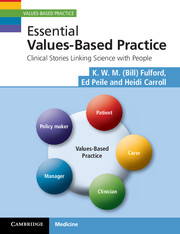Book contents
- Frontmatter
- Review quotes
- Contents
- Foreword
- Acknowledgements
- A bold claim to start this book
- Prologue: linking science with people
- Part 1 Values, individuals and an overview of values-based practice
- Part 2 The clinical skills for values-based practice
- Part 3 Relationships in values-based practice
- Part 4 Science and values-based practice
- Part 5 Bringing it all together
- Postcript: the small change of care
- A bold claim to end this book
- Appendix A Values-based practice summary and definitions of key terms
- Appendix B Values-based practice teaching framework
- Index
Part 5 - Bringing it all together
Published online by Cambridge University Press: 05 June 2012
- Frontmatter
- Review quotes
- Contents
- Foreword
- Acknowledgements
- A bold claim to start this book
- Prologue: linking science with people
- Part 1 Values, individuals and an overview of values-based practice
- Part 2 The clinical skills for values-based practice
- Part 3 Relationships in values-based practice
- Part 4 Science and values-based practice
- Part 5 Bringing it all together
- Postcript: the small change of care
- A bold claim to end this book
- Appendix A Values-based practice summary and definitions of key terms
- Appendix B Values-based practice teaching framework
- Index
Summary
Introduction to Part 5
The elements of values-based practice taken separately, as the stories in Parts 2–4 of this book illustrate, may each be helpful in their own right in supporting good practice. Bring these elements together, however, and use them in a well-joined-up way, and you get a turbo-charging effect. It is this turbo-charging effect that is shown in different ways by the two chapters in this final part of the book.
Chapter 13: one way in which the elements of values-based practice come together in practice is through the tenth element of the process itself, dissensus. We introduced the idea of dissensus and how it differs from the more familiar consensus in our overview of values-base practice in Chapter 2. Briefly:
– In consensual decision-making, differences of values are merged (this is what it means to “come to a consensus”).
– In dissensual decision-making, by contrast, differences of values remain in play as a resource for balanced decision-making according to the particular circumstances presented by each individual case.
The story in this chapter shows how the elements of values-based practice came together to support a positive process of dissensus in the story of a dying man, Joe Monaghan, and the decisions that he and his family made in partnership with an in-reach palliative care consultant, Dr. Emma Barnes, and other members of the multidisciplinary team.
Chapter 14: a second way in which the elements of values-based practice come together in practice is through the development of shared frameworks of values.
- Type
- Chapter
- Information
- Essential Values-Based PracticeClinical Stories Linking Science with People, pp. 163 - 164Publisher: Cambridge University PressPrint publication year: 2012



